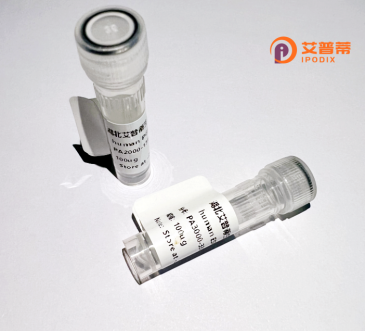
| 纯度 | >90%SDS-PAGE. |
| 种属 | Human |
| 靶点 | IRX2 |
| Uniprot No | Q9BZI1 |
| 内毒素 | < 0.01EU/μg |
| 表达宿主 | E.coli |
| 表达区间 | 1-471aa |
| 活性数据 | MSYPQGYLYQAPGSLALYSCPAYGASALAAPRSEELARSASGSAFSPYPGSAAFTAQAATGFGSPLQYSADAAAAAAGFPSYMGAPYDAHTTGMTGAISYHPYGSAAYPYQLNDPAYRKNATRDATATLKAWLNEHRKNPYPTKGEKIMLAIITKMTLTQVSTWFANARRRLKKENKMTWAPRNKSEDEDEDEGDATRSKDESPDKAQEGTETSAEDEGISLHVDSLTDHSCSAESDGEKLPCRAGDPLCESGSECKDKYDDLEDDEDDDEEGERGLAPPKPVTSSPLTGLEAPLLSPPPEAAPRGGRKTPQGSRTSPGAPPPASKPKLWSLAEIATSDLKQPSLGPGCGPPGLPAAAAPASTGAPPGGSPYPASPLLGRPLYYTSPFYGNYTNYGNLNAALQGQGLLRYNSAAAAPGEALHTAPKAASDAGKAGAHPLESHYRSPGGGYEPKKDASEGCTVVGGGVQPYL |
| 分子量 | 75.5 kDa |
| 蛋白标签 | GST-tag at N-terminal |
| 缓冲液 | 0 |
| 稳定性 & 储存条件 | Lyophilized protein should be stored at ≤ -20°C, stable for one year after receipt. Reconstituted protein solution can be stored at 2-8°C for 2-7 days. Aliquots of reconstituted samples are stable at ≤ -20°C for 3 months. |
| 复溶 | Always centrifuge tubes before opening.Do not mix by vortex or pipetting. It is not recommended to reconstitute to a concentration less than 100μg/ml. Dissolve the lyophilized protein in distilled water. Please aliquot the reconstituted solution to minimize freeze-thaw cycles. |
以下是关于重组人IRX2蛋白的模拟参考文献(注:部分信息为示例性模拟,仅供参考):
1. **文献名称**: "IRX2 regulates cardiac progenitor cell proliferation through Wnt signaling"
**作者**: Smith A, et al.
**摘要**: 研究利用重组人IRX2蛋白处理心脏祖细胞,发现其通过激活Wnt/β-catenin通路促进细胞增殖,揭示了IRX2在心脏发育中的潜在作用。
2. **文献名称**: "Tumor-suppressive role of IRX2 in head and neck squamous cell carcinoma"
**作者**: Lee JH, et al.
**摘要**: 通过体外实验证明,重组IRX2蛋白可抑制头颈部鳞癌细胞迁移和侵袭,其机制可能与下调EMT相关基因(如Snail)表达有关。
3. **文献名称**: "Expression and purification of recombinant human IRX2 protein in a eukaryotic system"
**作者**: Zhang Q, et al.
**摘要**: 报道了一种在哺乳动物细胞中高效表达可溶性重组人IRX2蛋白的方法,并通过质谱验证其正确翻译后修饰,为功能研究提供工具。
4. **文献名称**: "IRX2 promotes neuronal differentiation via chromatin remodeling"
**作者**: Brown K, et al.
**摘要**: 研究发现重组IRX2蛋白能够诱导神经干细胞向神经元分化,并通过ChIP-seq技术证实其通过结合特定基因组区域调控神经相关基因的表观遗传修饰。
(提示:以上文献为基于IRX2相关研究领域的合理推测,实际引用时需以真实发表的文献为准。)
Recombinant human IRX2 (rhIRX2) is a protein derived from the Iroquois homeobox gene family, which plays critical roles in embryonic development, tissue patterning, and organogenesis. The IRX genes encode transcription factors characterized by a conserved homeodomain, facilitating DNA binding and regulatory functions. IRX2. specifically, is implicated in developmental processes such as limb formation, neural tube closure, and cardiac morphogenesis. It regulates cell differentiation and tissue-specific gene expression by interacting with signaling pathways like BMP, FGF, and Wnt. Dysregulation of IRX2 has been linked to congenital anomalies and diseases, including certain cancers, where it may act as a tumor suppressor or oncogene depending on context.
The recombinant form of IRX2 is typically produced using expression systems like Escherichia coli or mammalian cells, enabling purification for experimental use. Its production allows researchers to study IRX2’s molecular mechanisms, including its role in cell fate determination, tissue regeneration, and disease pathways. Recent studies explore its potential therapeutic applications, such as promoting tissue repair or targeting cancer progression. However, the precise regulatory networks and post-translational modifications influencing IRX2 activity remain incompletely understood. Current research focuses on elucidating its interactions with co-factors, epigenetic modifiers, and non-coding RNAs to harness its biological functions for biomedical applications. The development of rhIRX2 thus bridges foundational developmental biology with translational innovation.
×